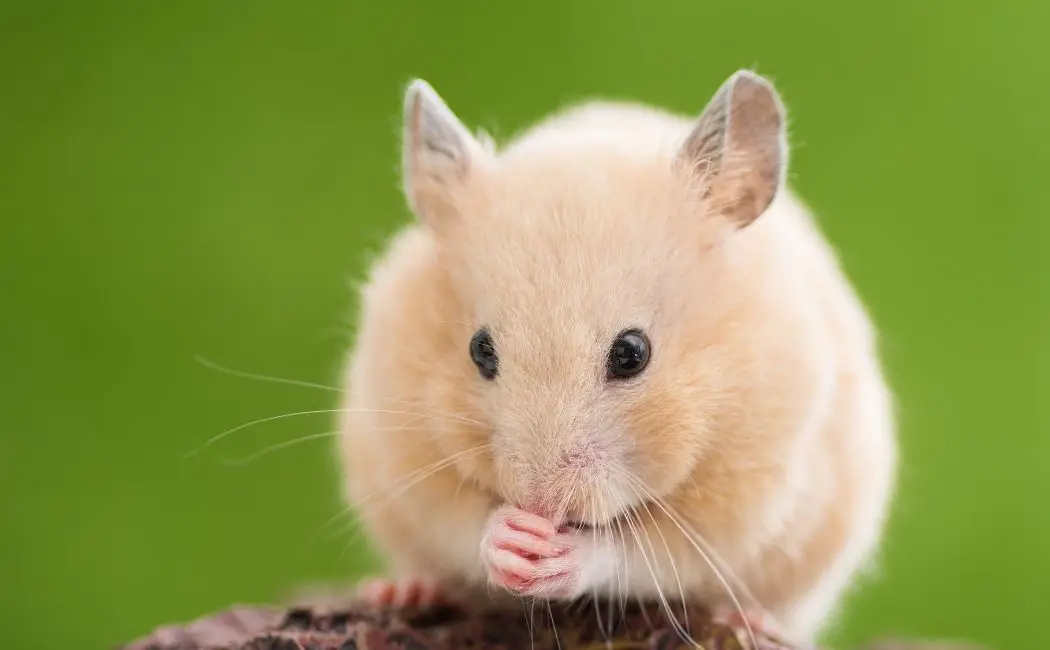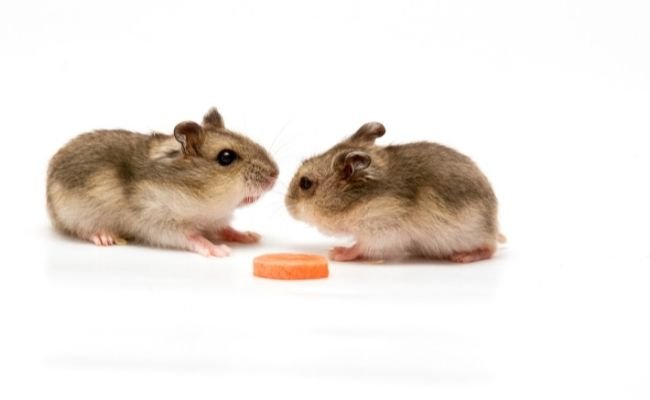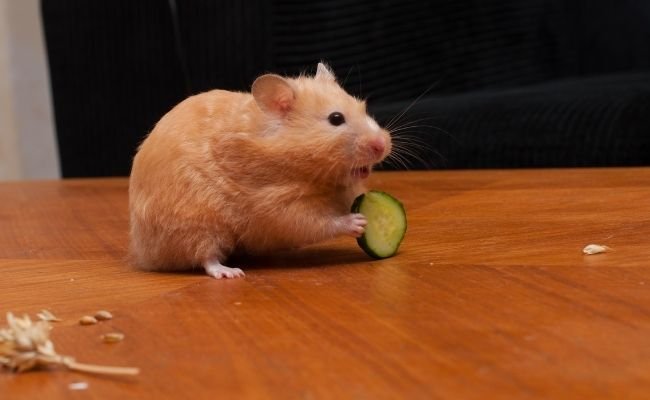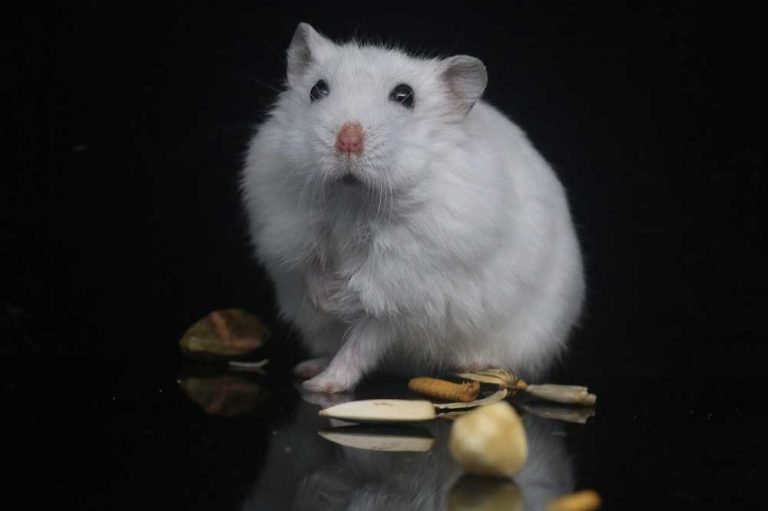Why Do Hamsters Put Food in Their Cheeks? (Explained!)
All hamsters have large cheek pouches which they use to store food. This is an adaptation that helps them survive in the wild, where they need to be able to carry food back to their burrows. The pouches are evaginations of the oral mucosa, which means that they can stretch all the way back to a hamster’s shoulders.
This allows them to carry a lot of food at once, making it more efficient for them to gather enough resources to survive. There are other benefits to having cheek pouches as well. They help protect a hamster’s food from predators, and they also keep the food from getting dirty or wet.
When a hamster is eating from its cheek pouch, it can close its mouth and cheeks tightly around the food so that nothing can get in or out. This makes it easier for them to eat on the go without having to stop and clean up their food first.
So why do hamsters put food in their cheeks? It’s an adaptation that helps them survive in the wild by making it easier for them to gather enough resources. Having cheek pouches also has some additional benefits, such as protecting their food from predators and keeping it clean and dry while they’re eating on the go.
What is the purpose of hamsters storing food in their cheek pouches?
Hamsters are unique among rodents in that they have large cheek pouches, which they use to store food. These pouches are evaginations of the oral mucosa and can stretch all the way back to the hamster’s shoulders. The primary purpose of the pouches is to transport food from place to place. In the wild, hamsters use their cheeks to bring food back to their burrows.
There are a number of advantages to this mode of transportation. First, it frees up the hamster’s hands for other activities such as digging or climbing. Second, it allows the hamster to move relatively quickly without having to stop and eat its food on the spot. Third, it enables the hamster to hoard its food and save it for later consumption.
The size of a hamster’s cheek pouches varies depending on the species, but all are capable of storing a considerable amount of food. When full, the pouches can make a hamster’s head appear much larger than usual. Some people find this amusing, but it is actually quite an efficient adaptation that allows hamsters to make the best use of their limited resources.
Do all hamsters store food in their cheek pouches?
Yes, all hamsters store food in their cheek pouches. These large pockets are evaginations of the oral mucosa and can stretch all the way back to a hamster’s shoulders.
The primary purpose of the pouches is to carry food from place to place. Hamsters use their cheek pouches to gather food and then move it to their mouths for eating or storing in their burrows.
How do hamsters store food in their cheek pouches?
Hamsters are able to store food in their cheek pouches due to a special feature of their anatomy. Their cheeks contain pouches that resemble small deflated balloons.
As food enters the mouth, the pouch expands and retractor muscles squeeze the pouch and pull food back into the cheek area. This allows the hamster to store a large amount of food in its cheek pouches, which can be helpful when it needs to cache food or carry food back to its burrow.
What type of food do hamsters typically store in their cheek pouches?
Most of the time, hamsters fill their cheeks with food, but sometimes they also store their babies in these pouches for protection. These pouches are located in the hamster’s cheeks and resemble small deflated balloons. As food enters the pouch, it expands and retractor muscles squeeze the pouch and pull the food back into the mouth.
There are a variety of different foods that hamsters may store in their cheek pouches, depending on their individual preferences and what is available to them. Some common examples include seeds, nuts, grains, vegetables, fruits, and insects.
In general, hamsters like to hoarde high-energy foods that they can eat later when they’re feeling sluggish or need a quick boost of energy.
How long can hamsters keep food in their cheek pouches?
In the wild, hamsters will store food in their cheek pouches until they’ve returned to the safety of their nesting area. Because hamsters are vulnerable to opportunistic predators in the wild, it is typically unsafe for them to pause and have a meal out in the open.
As such, these furry little rodents have evolved to be able to keep food in their cheek pouches for extended periods of time – up to several hours at a stretch! But what happens if you have a pet hamster that lives indoors? Well, there’s no need to worry – your furry friend can still pack away some food in its cheeks when necessary.
For example, if you’re getting ready to clean out your hamster’s cage and it looks like your pet is going to be without food for a while, it may stuff its cheeks full of kibble or other snacks so that it has something to eat later on.
So how long can hamsters keep food in their cheek pouches? While there isn’t an exact answer, as it depends on the size of the hamster and the type of food being stored, generally speaking, most hamsters can hold onto food in their cheek pouches for several hours at a time with no problem.
What happens to food that is stored in hamsters’ cheek pouches for too long?
When hamsters store food in their cheek pouches, they are essentially creating a little cache that they can come back to later. This is a common behavior for many animals that hoard food, as it allows them to have an emergency stash in case of famine or other difficult times.
However, if food is stored in the cheek pouches for too long, it will start to rot and become moldy. This can be extremely dangerous for the hamster, as they can end up ingesting harmful toxins that can make them very sick. In some cases, this can even be fatal.
So it’s important to make sure that any food that is being stored in a hamster’s cheek pouch is fresh and not past its expiration date. If you’re unsure whether or not the food is still good, it’s always better to err on the side of caution and throw it out rather than risk your hamster’s health.
Do hamsters ever eat the food they have stored in their cheek pouches?
Hamsters are known for their cheek pouches, which they use to store food. But do they ever actually eat the food they’ve stored in their cheeks? It turns out that hamsters do sometimes eat the food they’ve stored in their cheek pouches.
Females may even carry or hide their babies in their cheek pouches, and then eat the food to nourish them. However, it’s not entirely clear why hamsters do this. Some experts believe that it helps them to digest their food more slowly and thoroughly.
How do hamsters retrieve food from their cheek pouches?
When a hamster wants to retrieve food from its cheek pouch, it uses its tongue and teeth to reach into the pouch and pull the food out. The process is similar to how humans use their hands to pick up food from a plate.
The reason why hamsters have cheek pouches in the first place is so they can store food in them for later consumption. When a hamster fills its cheeks with food, it is able to eat more than it would if it didn’t have the pouches. This helps the hamster get through times when there is not as much food available.
What are the potential risks of hamsters storing food in their cheek pouches?
A hamster’s cheek pouch becomes impacted when they are, for some reason, unable to fully empty their cheeks of food. If a piece of food becomes lodged within the cheek pouch and the hamster cannot remove it themselves, infection is possible. This is because the food will, over time, rot inside of the hamster’s mouth.
There are several potential risks associated with this situation. First, if the food item is sharp or jagged, it could cut or scrape the inside of the cheek pouch, leading to an infection. Second, as the food rots, it will release bacteria that can cause an infection in both the mouth and stomach. Finally, if left untreated, this condition could lead to sepsis (a potentially life-threatening condition caused by bacteria in the blood).
If you suspect that your hamster has an impacted cheek pouch, it is important to take them to a veterinarian as soon as possible. The vet can determine whether or not there is an infection present and start your pet on antibiotics if necessary. They may also need to perform surgery to remove any foreign objects from the cheek pouch.
Are there any benefits to hamsters storing food in their cheek pouches?
A hamster’s ability to expand its cheeks is a biological necessity. In the wild, hamsters avoid becoming a predator’s snack by using their cheek pouches to store extra food during the day. That way, they don’t have to go out at night to forage for more food. Hamsters also use it to transport bedding.
There are several benefits to this behavior. First, it helps the hamster avoid being eaten by predators. Second, it allows the hamster to save energy by not having to forage for food at night. Third, it gives the hamster a place to store bedding material so that it can build a comfortable nest.
What Should a Hamster Owner Know About Cheek Pouches?
Most people are familiar with the concept of a hamster storing food in its cheek pouches, but there are some things that you may not know about this behavior. Here are a few things to keep in mind if you have a hamster as a pet:
First, it is perfectly normal for your hamster to stuff both of its cheeks with food. This is simply how they store their food for later consumption. However, you may also notice your hamster only stuffing one side of its cheeks. This is also normal behavior and is nothing to be concerned about.
Another thing to keep in mind is that your hamster may carry its food around or even back to its bedding via its cheek pouches. This is another perfectly normal behavior and should not be cause for concern. In fact, many hamsters will continue to eat even after filling their cheek pouches!
So, what should you do if you notice your hamster stuffing its cheeks with food? There’s really no need to worry – just let them be! Your furry friend is simply doing what comes natural to them.
Can Hamsters Get Food Stuck in Their Cheeks?
Hamsters are small, rodent-like creatures that are native to Europe and Asia. They are popular pets in many parts of the world and are known for their cute, furry appearance. Hamsters have cheek pouches on either side of their faces, which they use to store food.
Sometimes, the food becomes stuck in these pouches and the hamster is unable to evacuate it on its own. This can be a serious problem, as the impacted food can cause health problems for the hamster. If you suspect that your hamster has an impacted pouch, take it to the vet immediately so that it can be treated.
How To Empty a Hamster Cheek Pouch
A hamster’s cheek pouches are used to store food. These pouches can become full and need to be emptied on a regular basis.
The natural method for a hamster to clear and empty its pouches is to use its two front paws to push the food forward and out of the mouth. You too can try to massage the impacted cheek(s) to attempt to free the food or debris that is stuck.
What Are the Most Common Hamster Cheek Pouch Problems?
The most common hamster cheek pouch problems are sharp objects, cuts and punctures, and overgrown teeth.
Sharp objects can cause your hamster to nick its face, resulting in a small cut or puncture. If the object is small enough, it may even be able to enter the mouth and cause more serious damage. Overgrown teeth can also protrude into the cheek, causing pain and discomfort.
If you notice your hamster trying to put something sharp in its mouth, or if it has a cut or puncture on its face, it’s important to take it to the vet right away. In most cases, these wounds can be treated quickly and easily. However, if they’re left untreated, they can become infected and cause serious health problems.
What is the purpose of hamsters storing food in their cheeks?
All hamsters have cheek pouches, which are large pockets that stretch back to their shoulders. These pouches are used to carry food from place to place. In the wild, hamsters use their cheeks to bring food back to their burrows.
The primary purpose of the cheek pouches is to store food. When a hamster finds food, they will stuff as much into their cheeks as possible and then take it back to their burrow, where they will cache it (hide it away). This ensures that they have a supply of food available in case of lean times.
How do hamsters store food in their cheeks?
Most of the time, hamsters store food in their cheeks by filling their cheeks with food. However, sometimes mother hamsters store their babies in their cheeks for protection.
Hamster cheeks contain pouches that resemble small deflated balloons. As food enters the pouch, it expands and retractor muscles squeeze the pouch and pull the food back. This allows the hamster to store a good amount of food in its cheek without having to worry about dropping any of it.
What type of food do hamsters typically store in their cheeks?
Hamsters are known for their ability to store food in their cheeks. This is a trait that is unique to hamsters and is not seen in other animals. Hamsters typically store food in their cheeks so that they can eat it later. This allows them to have a constant supply of food, which is important for their survival.
There are two types of food that hamsters typically store in their cheeks: seeds and nuts. Seeds are a major part of the hamster diet and are essential for their health. Nuts provide the hamster with a source of protein and fat, which is also important for their health. Hamsters will often cache (or hoard) both seeds and nuts so that they have an emergency supply of food.
What happens if a hamster doesn’t store food in its cheek?
A hamster’s cheek pouch is used to store food. When a hamster eats, the food is stored in the cheek pouches. The pouches are located on either side of the hamster’s head, just behind the cheeks. If a hamster doesn’t store food in its cheek pouches, the food will go straight to the stomach and then be digested.
There are several reasons why a hamster might not store food in its cheek pouches. One reason could be that the muscles that control the pouches are not working properly. Another possibility is that there is something blocking the opening of the pouch, such as a piece of food that has become lodged there.
If a piece of food becomes lodged in the pouch and the hamster cannot remove it themselves, infection is possible. This is because the food will, over time, rot inside of the hamster’s mouth.If you think your hamster isn’t storing food in its cheek pouches, take it to see a veterinarian right away.
Do all hamsters store food in their cheeks?
Yes, all hamsters have cheek pouches, which are large pockets that stretch back to their shoulders. The primary purpose of these pouches is to carry food from place to place. In the wild, hamsters use their cheeks to bring food back to their burrows.
So, do all hamsters store food in their cheeks? The answer is yes! All hamsters use their cheek pouches to carry food around with them. This enables them to transport a lot of food at once and helps them keep track of where they’ve been foraging.
Additionally, storing food in their cheeks allows hamsters to eat on the go and later on when they’re back in their burrows.
How did hamsters evolve to store food in their cheeks?
Hamsters are small, adorable rodents that have been domesticated as pets for centuries. But these furry little creatures are not just cute; they’re also fascinating and unique animals with a variety of behaviors and adaptations that set them apart from other rodent species. One of the most well-known hamster behaviors is their ability to store food in their cheeks.
But how did hamsters evolve to develop this interesting trait? Scientists believe that hamsters evolved to store food in their cheeks as an adaptation to their arid, desert habitats. In these environments, food can be scarce, so storing up supplies for lean times is essential for survival.
When a hamster finds a good cache of food, they stuff as much into their cheek pouches as possible and carry it back to their burrow, where they can eat it at leisure later on. Interestingly, not all hamsters display this behavior; only those that live in desert habitats have developed this adaptation. This suggests that it’s an environmental response rather than a genetic one.
Is storing food in their cheeks the only way hamsters can store food?
No, storing food in their cheeks is not the only way hamsters can store food. In fact, hamsters have been known to carry more than just food in their cheek pouches. They may move some bedding this way if they are forming a nest. It is also not at all unheard of for a mother hamster to store her pups in these massive pouches.
What other animals store food in their cheeks?
Mammals are not the only animals that have cheek pouches. Some reptiles, such as iguanas and certain snakes, also have these pockets on the sides of their heads. These pouches are used to store food, which the animal can then eat later on.
Cheek pouches are found in a variety of different animals because they offer a number of advantages. For example, they allow an animal to eat more quickly and efficiently since they do not have to take time to chew their food properly. Additionally, cheek pouches protect food from being crushed by the teeth while it is being stored. This is especially important for animals that eat hard-shelled prey, such as crabs or nuts.
There are some disadvantages to having cheek pouches as well. One downside is that if an animal is attacked while it has food in its cheeks, the attacker can easily access this cache of food and steal it away. Another potential problem is that if an animal eats too much at once, the contents of its cheek pouch may become stuck and be difficult to remove.







